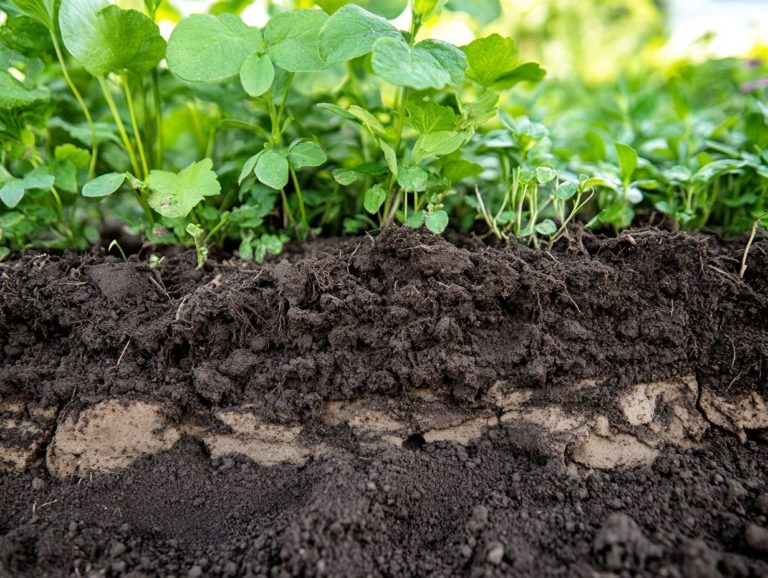What Is Cation Exchange Capacity in Soil?
Cation Exchange Capacity (CEC) is a vital aspect of soil health that greatly impacts plant growth and nutrient availability. It is influenced by various soil cations.
This article delves into the definition of CEC and its significance. You ll discover the factors that influence it, including soil properties, management practices, and the role of negatively charged particles.
By exploring methods to enhance CEC, you can ensure your soil is primed for optimal plant development.
Are you ready to unlock the secrets of soil fertility?
Contents
- Key Takeaways:
- Understanding Cation Exchange Capacity (CEC)
- Factors Affecting CEC
- Measuring CEC
- Interpreting CEC Results
- Improving CEC
- Methods for Increasing CEC in Soil
- Frequently Asked Questions
- What is Cation Exchange Capacity in Soil?
- How is Cation Exchange Capacity measured?
- What factors influence Cation Exchange Capacity, including base saturation and soil texture?
- Why is Cation Exchange Capacity important?
- How does Cation Exchange Capacity impact soil management?
- Can Cation Exchange Capacity be improved?
- Frequently Asked Questions
Key Takeaways:

- Cation Exchange Capacity (CEC) measures a soil’s ability to hold and exchange positively charged nutrient particles that play a vital role in plant growth.
- Soil properties and management practices, such as pH level and organic matter content, strongly influence CEC. Understanding these factors can help improve CEC and plant health.
- There are various methods for measuring and improving CEC, including soil amendments and proper management techniques. Optimize your CEC today to boost crop productivity and soil health.
Understanding Cation Exchange Capacity (CEC)
Cation Exchange Capacity (CEC) is a cornerstone property of soil, highlighting its ability to retain and exchange positively charged nutrient particles known as cations. These particles are essential for soil fertility, influencing the availability of vital nutrients like potassium (K+), calcium (Ca++), and magnesium (Mg++).
Understanding CEC is crucial for effective soil management. It directly impacts nutrient retention, soil texture, and the overall vitality of different soil types.
Definition and Importance
Cation Exchange Capacity (CEC) measures your soil’s ability to hold and exchange positively charged nutrient cations. This plays a crucial role in maintaining soil fertility and supporting plant growth.
For both farmers and gardeners, understanding CEC is essential. It directly impacts the availability of key nutrients like calcium, magnesium, and potassium.
Soils with higher CEC values retain more cations, enhancing fertility and making them better suited for various crops. Remember, soil pH significantly influences CEC; lower pH can lead to nutrient leaching, diminishing soil fertility.
The texture of your soil whether clay, silt, or sand affects CEC values. Clay soils usually have higher CEC than sandy soils due to their larger surface area and superior ability to hold water and nutrients. Understanding these dynamics empowers you to cultivate a more productive and vibrant garden or farm.
Factors Affecting CEC
Cation Exchange Capacity (CEC) is influenced by various factors you should be aware of. Soil properties, including texture and organic matter content, play a significant role.
The presence of clay minerals and negatively charged ions also contributes to overall CEC dynamics, affecting base saturation levels within the soil. Understanding these elements can enhance your approach to soil management and fertility.
Soil Properties and Management Practices

Soil properties, such as organic matter content and texture, play a crucial role in influencing the soil’s ability to hold nutrients, known as Cation Exchange Capacity (CEC). This, in turn, affects your soil management practices aimed at optimizing soil fertility.
Understanding these dynamics is essential if you want to enhance agricultural productivity. By increasing organic matter through techniques like cover cropping or composting, you not only boost CEC but also improve water retention and nutrient availability.
The texture of your soil whether it s sandy, clayey, or loamy significantly impacts how effectively it can hold and exchange nutrients that are vital for plant nutrition.
Utilizing soil testing labs helps you accurately assess your CEC levels. This enables you to make informed decisions that lead to tailored amendments and optimized fertilizer applications. Such an approach fosters a healthier, more productive soil environment.
Measuring CEC
Measuring Cation Exchange Capacity (CEC) is crucial for understanding soil fertility. This is typically accomplished through a range of soil testing methods, each offering valuable insights into the CEC values found in soil test reports.
Understanding these values can significantly enhance your approach to soil management and crop production.
Common Techniques and Interpretations
Common techniques for measuring Cation Exchange Capacity (CEC) include saturation methods and extraction techniques. These methods empower you to interpret CEC values for enhanced soil management and agricultural practices.
These methodologies offer vital insights into the nutrient-holding capacity of soils. This enables informed decisions about fertilization and crop selection.
For example, laboratories often employ the ammonium acetate saturation method, which displaces nutrients from the soil and analyzes their concentrations to determine CEC. The results from such tests reveal the overall nutrient retention potential and pinpoint specific deficiencies that may require your attention.
By understanding CEC, you can tailor amendments more effectively, leading to improved soil fertility and healthier crops.
Interpreting CEC Results
Interpreting Cation Exchange Capacity (CEC) results is essential for understanding how CEC affects plant growth and nutrient availability. Variations in soil pH and nutrient cations can significantly impact your gardening or agricultural endeavors.
When you understand these dynamics, you can make better choices for your plants, enhancing plant health and optimizing nutrient use.
How CEC Affects Plant Growth and Nutrient Availability

Cation Exchange Capacity (CEC) plays a pivotal role in plant growth by impacting nutrient availability. Higher CEC values mean your soil can retain essential nutrients crucial for optimal plant health.
This nutrient retention is especially important for different crops. For example, legumes thrive in soils with higher CEC, allowing them to access more nitrogen, vital for their growth.
Shallow-rooted crops, like radishes, may struggle in low CEC soils. Their limited root depth makes it difficult to reach the nutrients they need.
CEC also helps maintain stable soil pH levels. Soils with greater CEC ensure nutrient availability, which ultimately influences your crop yield and quality.
Improving CEC
Act now to enhance your Cation Exchange Capacity (CEC) using these proven methods. One impactful strategy is the incorporation of organic matter.
This significantly boosts the soil’s ability to retain essential beneficial nutrients, improving overall soil fertility. By taking these steps, you’re setting the foundation for healthier, more productive soil.
Start testing your soil today for a thriving garden!
Methods for Increasing CEC in Soil
Want to boost your garden’s health? Start with Cation Exchange Capacity (CEC). It s all about adding organic matter and nutrients.
One effective method is composting. Enrich your soil with decomposed materials to enhance its capacity to hold nutrients like calcium, magnesium, and potassium.
Cover cropping is another great strategy. By planting specific crops and turning them back into the soil, you add organic matter and stimulate microbial activity.
Certain fertilizers, especially those rich in calcium, magnesium, or potassium, can also help elevate cation levels.
By implementing these strategies, you cultivate a robust ecosystem. This not only improves plant growth but also supports sustainable practices, benefiting both your crops and the environment.
Frequently Asked Questions
What is Cation Exchange Capacity in Soil?

Cation Exchange Capacity (CEC) is a measure of a soil’s ability to hold positively charged ions, called cations, which are nutrients like potassium and calcium that plants need. It is an important factor in determining a soil’s fertility and nutrient availability for plants.
How is Cation Exchange Capacity measured?
CEC is measured in units of milliequivalents per 100 grams of soil (meq/100g). Soils with a high CEC have a greater ability to hold and exchange cations, while soils with a low CEC have a lesser ability.
What factors influence Cation Exchange Capacity, including base saturation and soil texture?
CEC is influenced by the type of clay and organic matter present in the soil, as well as the soil’s pH. Soils with high clay and organic matter content typically have a higher CEC, while soils with low levels of these components have a lower CEC.
Why is Cation Exchange Capacity important?
CEC is important because it affects a soil’s ability to hold and release nutrients for plant uptake. Soils with a higher CEC can hold onto essential nutrients like potassium, calcium, and magnesium, making them more available for plant growth.
How does Cation Exchange Capacity impact soil management?
Understanding a soil’s CEC can help farmers and gardeners make better decisions about fertilization and nutrient management. Soils with a high CEC may require more frequent fertilization, while soils with a low CEC may benefit from regular additions of organic matter to increase nutrient availability.
Can Cation Exchange Capacity be improved?
Yes, CEC can be improved through practices like adding organic matter, using cover crops, and using soil amendments like lime to adjust pH levels. These actions can increase the nutrient-holding capacity of the soil and improve overall soil health.






